IDEF1X, Crowsfoot and Chen Modeling ER Diagrams
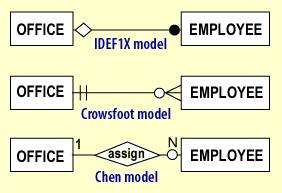
The image illustrates three different Entity-Relationship Diagram (ERD) notation:
- IDEF1X
- Crow’s Foot
- Chen Notation
modeling the same relationship between `OFFICE` and `EMPLOYEE`. Each style conveys the one-to-many relationship with distinct visual syntax:
-
✅ IDEF1X Model
- Symbols Used:
- Solid black circle on the EMPLOYEE side: indicates a dependent entity.
- Diamond connector: indicates a relationship.
- Solid line: represents an identifying relationship (child inherits part of the parent’s PK).
- Interpretation:
EMPLOYEEis a dependent entity.- Each employee must be assigned to exactly one office.
- An office can have many employees.
- This is a mandatory one-to-many (1:N) identifying relationship.
- Symbols Used:
-
✅ Crow’s Foot Model
- Symbols Used:
- Two vertical bars (||) next to
OFFICE: indicates mandatory one. - Crow’s foot with a circle near
EMPLOYEE: indicates zero or many.
- Two vertical bars (||) next to
- Interpretation:
- Each employee may or may not be assigned to an office.
- Each office must have one or more employees.
- This represents a mandatory one-to-many relationship from
OFFICEtoEMPLOYEE, but with optional participation fromEMPLOYEE.
- Symbols Used:
-
✅ Chen Model
- Symbols Used:
- Diamond labeled "assign": denotes the relationship.
- "1" near
OFFICEand "N" nearEMPLOYEE: represents cardinality.
- Symbols Used:
🔄 Comparison Table
| Notation | Relationship Type | Direction | Optionality / Notes |
|---|---|---|---|
| IDEF1X | Identifying 1:N | OFFICE → EMPLOYEE | EMPLOYEE is dependent on OFFICE |
| Crow’s Foot | Mandatory 1 to (0..*) | OFFICE → EMPLOYEE | EMPLOYEE can be optionally assigned |
| Chen | 1:N | OFFICE → EMPLOYEE | Uses "assign" to describe relationship |
Interpretation:
- Each employee is assigned to one office.
- Each office may have many employees.
- This is a standard 1:N (one-to-many) relationship.
📌 Summary All three notations express the same logical model: an OFFICE can have many EMPLOYEEs, but the notations differ in how they depict cardinality, dependency, and optional participation. The choice of notation depends on the modeling standard used in the organization or project.
I. IDEF1X Notation
Question:
Answer: This page introduces IDEF1X and identifies the notation, so that standard-compliant data models can be read and fully understood. There are many closely related subjects, which require formal education and the links are provided below in the list.
- "What is IDEF1X ?" or
- "What does this symbol mean?"
Answer: This page introduces IDEF1X and identifies the notation, so that standard-compliant data models can be read and fully understood. There are many closely related subjects, which require formal education and the links are provided below in the list.
- the Relational Model
- 2nd and 3rd Normal Forms in general, and the specific Relational Normalization identified in the Relational Model.
- The IDEF1X Methodology or Relational Database Design
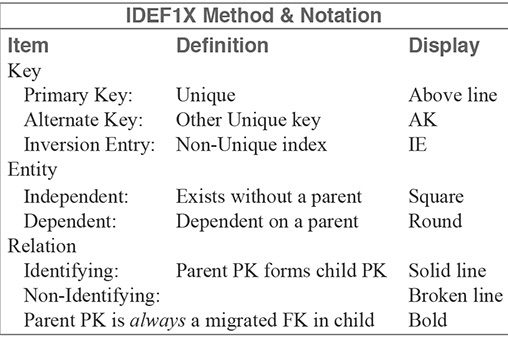
| Item | Definition | Display |
|---|---|---|
| Key | ||
| Primary Key | Unique | Above line |
| Alternate Key | Other Unique key | AK |
| Inversion Entry | Non-Unique index | IE |
| Entity | ||
| Independent | Exists without a parent | Square |
| Dependent | Dependent on a parent | Round |
| Relation | ||
| Identifying | Parent PK forms child PK | Solid line |
| Non-Identifying | Parent PK is not child PK | Broken line |
| Parent PK | is always a migrated FK in child | Bold |
- Item: Key, Entity, Relation
- Key Definitions:
- Primary Key: Unique
- Alternate Key: Other Unique key
- Inversion Entry: Non-Unique index
- Entity Definitions:
- Independent: Exists without a parent
- Dependent: Dependent on a parent
- Relation Definitions:
- Identifying: Parent PK forms child PK
- Non-Identifying: Parent PK is always a migrated FK in child
- Display Notations:
- Primary Key: Above line
- Alternate Key: AK
- Inversion Entry: IE
- Independent Entity: Square
- Dependent Entity: Round
- Identifying Relation: Solid line
- Non-Identifying Relation: Broken line
- Parent PK in Non-Identifying Relation: Bold
Description of Relevant Features:
- Design and Layout: The table is organized into three columns: Item, Definition, and Display. This layout helps in clearly distinguishing between the terminology, its definition, and its visual representation in IDEF1X diagrams.
- Notation Symbols: The use of different symbols and lines to represent various database concepts (like primary keys, alternate keys, and types of relations) aids in visually differentiating the components of a database schema.
- Use of Text Styles: Bold and italics are used to emphasize key aspects of the notation, such as the primary key always being a migrated foreign key in non-identifying relationships.
- Clarity and Purpose: The image provides a quick reference for understanding how different elements are represented in an IDEF1X model, which is beneficial for database designers and those studying database modeling.
These features make the IDEF1X method and notation effective for visually representing complex database schemas in a structured and standardized manner.
Database Systems
IEEE Relation Notation:
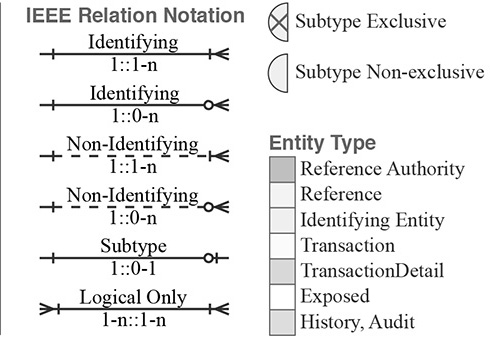
- IEEE Relation Notation:
- Identifying: 1:1-n
- Identifying: 1:0-n
- Non-Identifying: 1:1-n
- Non-Identifying: 1:0-n
- Subtype: 1:0-1
- Logical Only: 1-n:1-n
- Symbols for Relations: Subtype Exclusive: Subtype Non-exclusive
- Entity Type:
- Reference Authority
- Reference
- Identifying Entity
- Transaction
- Transaction Detail
- Exposed
- History, Audit
Description of Relevant Features:
- Notation Style: The diagram uses various arrows and lines to represent different types of relationships in a database, such as identifying and non-identifying relationships.
- Entity Type List: A list of different types of entities such as Reference Authority, Transaction Detail, etc., likely represents different roles or purposes that entities might have within a database schema.
- Subtype Indicators: Circles marked "Subtype Exclusive" and "Subtype Non-exclusive" are likely used to indicate whether an entity can simultaneously be more than one subtype or exclusively one subtype.
- Relationship Multiplicity: The notation 1:1-n, 1:0-n, 1:0-1, 1-n:1-n provides the cardinality and optionality of the relationships, indicating how many instances of an entity type can be associated with instances of another type.
- Logical Representation: The "Logical Only" relationship suggests a conceptual link that might not necessarily be implemented directly in the database but is important for understanding the schema.
- Clarity and Educational Value: The diagram provides clear, visual representations that can help users quickly understand complex relationships and entity types in database design, making it a useful educational and reference tool.
This style of representation is essential for database designers, especially in complex systems, where understanding the relationships between different entities accurately is crucial for data integrity and performance.
Database Systems
Context and Purpose
- IDEF1X stands for Integrated Definition, and belongs to a set of six such definitions, each of which is tightly constructed and integrated with the others. 1 is for Information Modelling, 1X is for Relational Data Modelling.
- It is a stricter implementation of the Relational Model by Dr E F Codd. It is based on the theory and techniques invented by Codd (the RM) and Dr P P S Chen (the Entity Relation Model). The initial technique (methodology) was developed by R R Brown, T L Ramey and D S Coleman. It was progressed and developed to this diagrammatic form by Robert Brown in the early 1980s.
- It is a methodology, specifically for modelling Relational databases.
- It was accepted and declared as a standard by National Institute of Standards and Technology (FIPS 184) in 1993. (IDEF0 may be used for Function Modelling.)
- It allows the data to be modelled:
- in the context of the whole organisation
- independent of the applications that use it
- completely (exposing all complexities and subtleties).
- using a standard notation (set of symbols) and nomenclature, so that all teams and users are served. This eliminates ambiguity, and ensures that the complete set of information (identified by the standard) is communicated in the single diagram.
- Competent use of the Methodology produces databases that are easy to change and extend, as well as easy to use, by users and future applications. The result is a more genuinely Relational database, which allows expansion, rather than replacement due to the limitations otherwise
- IDEF1X is widely accepted in organisations that require compliance to Standards (Government departments, US DoD, aircraft manufacturers, large banks). It is viewed as a mark of quality, a genuine Relational database.
II. Crows Foot Notation and Example
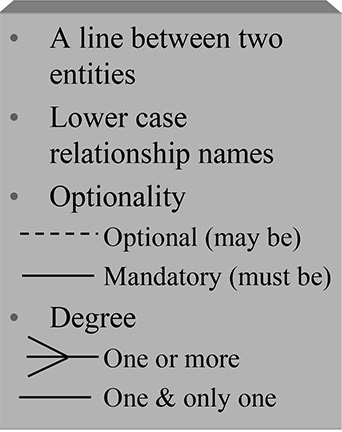
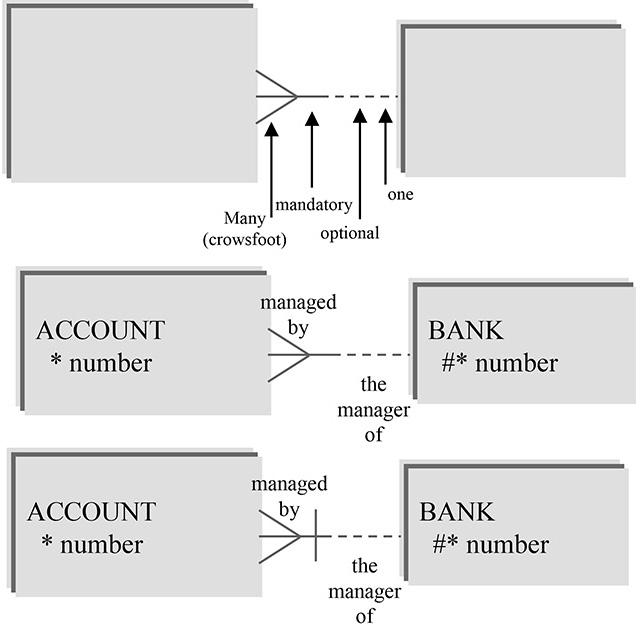
Break down the relationships shown in the diagram:
🧾 Entities and Attributes
-
ACCOUNT
- Has a primary key attribute:
* number - This implies that the
numberis a unique identifier for each account.
- Has a primary key attribute:
-
BANK
- Has a composite key:
#* number- The
#symbol typically denotes that it is a foreign key, while*means it’s also a primary key. - So
numberin BANK is part of its primary key and may be a foreign key in some cases.
- The
- Has a composite key:
🔁 Relationships
There are two variations of the relationship depicted:
-
First Relationship (Middle of Image):
- Labeled:
"managed by"fromACCOUNTtoBANK - The relationship text on the reverse path is:
"the manager of" - The symbol between the entities:
- Crow’s foot at
ACCOUNTside → indicates many accounts - Circle and dash at
BANKside → means optional one bank
- Crow’s foot at
- Interpretation:
- Each ACCOUNT is optionally managed by one BANK.
- A BANK can manage many ACCOUNTS.
- Some accounts might not be managed by any bank, indicating the optionality.
- Labeled:
-
Second Relationship (Bottom of Image):
- Also labeled:
"managed by"fromACCOUNTtoBANK - But the symbol changes at the BANK side:
- Straight line and dash (instead of circle) → indicates mandatory one bank
- Interpretation:
- Each ACCOUNT must be managed by one BANK.
- A BANK can manage many ACCOUNTS.
- This is a mandatory 1:N relationship (1 Bank ↔ N Accounts), with no optionality on the ACCOUNT side.
- Also labeled:
| Aspect | Top Version (Middle) | Bottom Version |
|---|---|---|
| Account to Bank | Optional many-to-one | Mandatory many-to-one |
| Bank to Account | One bank → many accounts | One bank → many accounts |
| Optionality on Bank side | Yes (optional bank) | No (must have a bank) |
📌 Summary This Crow's Foot diagram presents a 1-to-many relationship between BANK and ACCOUNT:
- A BANK can manage multiple ACCOUNTS
- An ACCOUNT can be managed by:
- Optionally one bank (middle diagram)
- Or must be managed by one bank (bottom diagram)
Chen Notation
Figure 7-3 shows the different types of relationships using two ER notations:
The left side of the ER diagram shows the Chen notation, based on Peter Chen's landmark paper. In this notation, the connectivities are written next to each entity box. Relationships are represented by a diamond connected to the related entities through a relationship line. The relationship name is written inside the diamond.
The right side of Figure 7-3 illustrates the Crow's Foot notation. The name "Crow's Foot" is derived from the three-pronged symbol used to represent the “many” side of the relationship. As you examine the basic Crow's Foot ERD in Figure 7-3, note that the connectivities are represented by symbols.
For example, the "1" is represented by a short line segment, and the "M" is represented by the three-pronged "crow's foot." In this example, the relationship name is written above the relationship line.
In Figure 7-3, entities and relationships are shown in a horizontal format, but they may also be oriented vertically. The entity location and the order in which the entities are presented are immaterial; just remember to read a 1:M relationship from the "1" side to the "M" side.
The Crow's Foot notation is used as the design standard in this book. However, the Chen notation is used to illustrate some of the ER modeling concepts whenever necessary. Most data modeling tools let you select the Crow’s Foot notation.
- the original Chen notation and the
- Crow's Foot notation.
The left side of the ER diagram shows the Chen notation, based on Peter Chen's landmark paper. In this notation, the connectivities are written next to each entity box. Relationships are represented by a diamond connected to the related entities through a relationship line. The relationship name is written inside the diamond.
The right side of Figure 7-3 illustrates the Crow's Foot notation. The name "Crow's Foot" is derived from the three-pronged symbol used to represent the “many” side of the relationship. As you examine the basic Crow's Foot ERD in Figure 7-3, note that the connectivities are represented by symbols.
For example, the "1" is represented by a short line segment, and the "M" is represented by the three-pronged "crow's foot." In this example, the relationship name is written above the relationship line.
In Figure 7-3, entities and relationships are shown in a horizontal format, but they may also be oriented vertically. The entity location and the order in which the entities are presented are immaterial; just remember to read a 1:M relationship from the "1" side to the "M" side.
The Crow's Foot notation is used as the design standard in this book. However, the Chen notation is used to illustrate some of the ER modeling concepts whenever necessary. Most data modeling tools let you select the Crow’s Foot notation.
Each of the three diagrams on represents the same relationship type as its corresponding Chen diagram.
The explanatory text below each individual diagram is identical and aligned horizontally across both notation styles:
- Top (1:1) "One to One" -> EMPLOYEE–STORE
- Middle (1:M) "One to Many" -> PAINTER–PAINTING
- Bottom (M:N) "Many to Many" -> EMPLOYEE–SKILL


